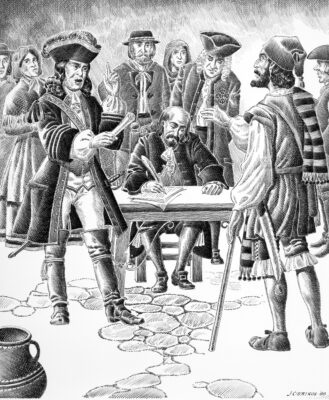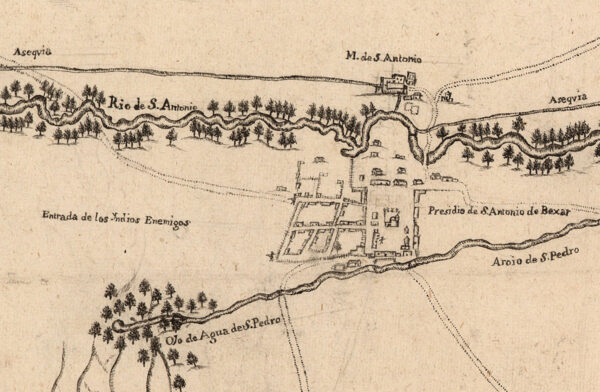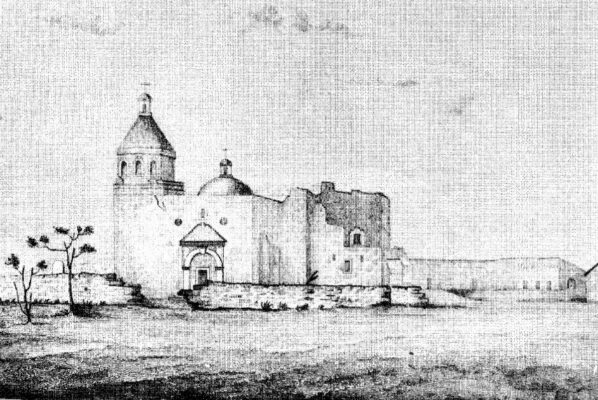A Poor Settlement Takes Shape at the Northern Frontier of New Spain
English
Español
-
By the early 1720s the mission, presidio, and villa, established by the Spanish on the upper reaches of San Pedro Creek, had been moved downstream and closer to the San Antonio River. The mission was located on the east side of the river, and the presidio was between San Pedro Creek and the river. The main structures of these new establishments were made of adobe and stone, while most of the houses were simple jacales. In 1731, 56 civilian settlers arrived from the Canary Islands with an order from the king of Spain to establish San Fernando de Béxar, the first such official villa in Spanish Texas. While the small military garrison contributed to the local barter economy, the civilian settlers and mission communities were supported by farming and ranching. And, like all isolated and poor frontier outposts, the settlers of early San Antonio eventually had to be self-reliant and produce most of their own domestic and agricultural goods.

Courtesy: University of Texas at San Antonio Libraries Special Collections. After the Canary Islanders arrived at Presidio San Antonio in 1731, the presidial commander, Juan Antonio Almazán, issued land titles to the new settlers, some of which were along the banks of San Pedro Creek. These were the first land grants in Texas from the Spanish crown.

Courtesy: John Carter Brown Library, Brown University, Providence, RI. This 1764 map shows the relocated presidio and mission and the Villa de San Fernando, the site granted to the Canary Island settlers. The villa buildings are shown between the presidio and the river.

Courtesy: University of Texas at San Antonio Libraries Special Collections. In addition to individual land titles, the new Canary Island community as a whole was granted lands for use as farms and ranches and a public plaza where they built their church, San Fernando. The limits of the villa, and ultimately the city of San Antonio, were centered on the front door of the church.
-
A principios de la década de 1720, la misión, el presidio y la villa, establecidos por los españoles en los tramos superiores de San Pedro Creek, se habían trasladado río abajo y más cerca del río San Antonio. La misión estaba ubicada en el lado este del río y el presidio estaba entre San Pedro Creek y el río. Las principales estructuras de estos nuevos establecimientos fueron de adobe y piedra, mientras que la mayoría de las viviendas eran simples jacales. En 1731, 56 colonos civiles llegaron de las Islas Canarias con una orden del rey de España para establecer San Fernando de Béxar, la primera villa oficial de este tipo en la Texas española. Mientras que la pequeña guarnición militar contribuyó a la economía de trueque local, los colonos civiles y las comunidades misioneras fueron apoyados por la agricultura y la ganadería. Y, como todos los puestos fronterizos pobres y aislados, los primeros colonos de San Antonio finalmente tuvieron que ser autosuficientes y producir la mayoría de sus propios productos domésticos y agrícolas.

Courtesy: University of Texas at San Antonio Libraries Special Collections. Después de la llegada de los canarios al Presidio San Antonio en 1731, el comandante del presidio, Juan Antonio Almazán, otorgó títulos de propiedad a los nuevos pobladores, algunos de los cuales se encontraban a orillas de San Pedro Creek. Estas fueron las primeras concesiones de tierras en Texas de la corona española.

Courtesy: John Carter Brown Library, Brown University, Providence, RI. Este mapa de 1764 muestra el presidio y la misión reubicados y la Villa de San Fernando, el sitio cedido a los colonos canarios. Los edificios de la villa se muestran entre el presidio y el río.

Courtesy: University of Texas at San Antonio Libraries Special Collections. Además de los títulos de propiedad individuales, a la nueva comunidad canaria en su conjunto se le otorgaron tierras para su uso como granjas y ranchos y una plaza pública donde construyeron su iglesia, San Fernando. Los límites de la villa, y finalmente la ciudad de San Antonio, se centraron en la entrada de la iglesia.

